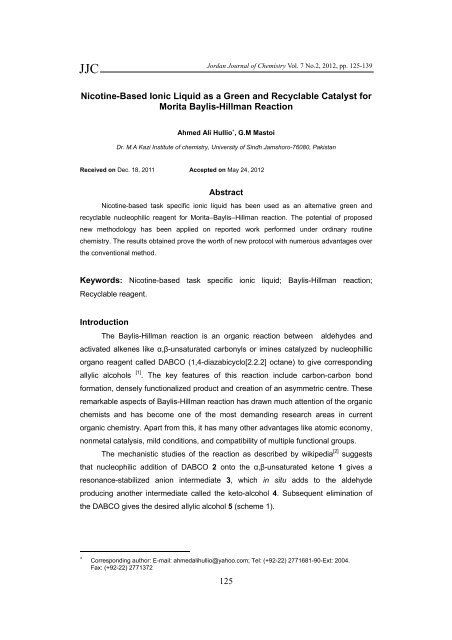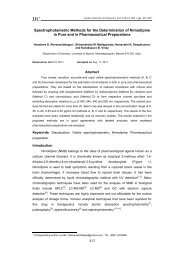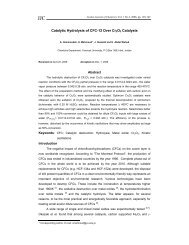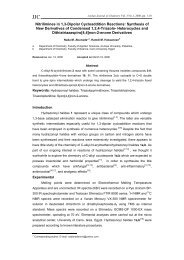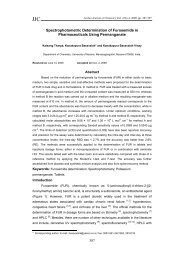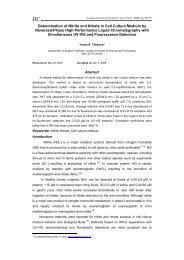125 Nicotine-Based Ionic Liquid as a Green and ... - Jjc.yu.edu.jo
125 Nicotine-Based Ionic Liquid as a Green and ... - Jjc.yu.edu.jo
125 Nicotine-Based Ionic Liquid as a Green and ... - Jjc.yu.edu.jo
Create successful ePaper yourself
Turn your PDF publications into a flip-book with our unique Google optimized e-Paper software.
JJCJordan Journal of Chemistry Vol. 7 No.2, 2012, pp. <strong>125</strong>-139<strong>Nicotine</strong>-<strong>B<strong>as</strong>ed</strong> <strong>Ionic</strong> <strong>Liquid</strong> <strong>as</strong> a <strong>Green</strong> <strong>and</strong> Recyclable Catalyst forMorita Baylis-Hillman ReactionAhmed Ali Hullio ∗ , G.M M<strong>as</strong>toiDr. M.A Kazi Institute of chemistry, University of Sindh Jamshoro-76080, PakistanReceived on Dec. 18, 2011 Accepted on May 24, 2012Abstract<strong>Nicotine</strong>-b<strong>as</strong>ed t<strong>as</strong>k specific ionic liquid h<strong>as</strong> been used <strong>as</strong> an alternative green <strong>and</strong>recyclable nucleophilic reagent for Morita–Baylis–Hillman reaction. The potential of proposednew methodology h<strong>as</strong> been applied on reported work performed under ordinary routinechemistry. The results obtained prove the worth of new protocol with numerous advantages overthe conventional method.Keywords: <strong>Nicotine</strong>-b<strong>as</strong>ed t<strong>as</strong>k specific ionic liquid; Baylis-Hillman reaction;Recyclable reagent.IntroductionThe Baylis-Hillman reaction is an organic reaction between aldehydes <strong>and</strong>activated alkenes like α,β-unsaturated carbonyls or imines catalyzed by nucleophillicorgano reagent called DABCO (1,4-diazabicyclo[2.2.2] octane) to give correspondingallylic alcohols [1] . The key features of this reaction include carbon-carbon bondformation, densely functionalized product <strong>and</strong> creation of an <strong>as</strong>ymmetric centre. Theseremarkable <strong>as</strong>pects of Baylis-Hillman reaction h<strong>as</strong> drawn much attention of the organicchemists <strong>and</strong> h<strong>as</strong> become one of the most dem<strong>and</strong>ing research are<strong>as</strong> in currentorganic chemistry. Apart from this, it h<strong>as</strong> many other advantages like atomic economy,nonmetal catalysis, mild conditions, <strong>and</strong> compatibility of multiple functional groups.The mechanistic studies of the reaction <strong>as</strong> described by wikipedia [2] suggeststhat nucleophilic addition of DABCO 2 onto the α,β-unsaturated ketone 1 gives aresonance-stabilized anion intermediate 3, which in situ adds to the aldehydeproducing another intermediate called the keto-alcohol 4. Subsequent elimination ofthe DABCO gives the desired allylic alcohol 5 (scheme 1).∗Corresponding author: E-mail: ahmedalihullio@yahoo.com; Tel: (+92-22) 2771681-90-Ext: 2004.Fax: (+92-22) 2771372<strong>125</strong>
Scheme 1This reaction is usually carried out under homogeneous conditions in thepresence of organic Lewis b<strong>as</strong>e catalysts such <strong>as</strong> DABCO, [3] DMAP, [4] DBU, [5] [6]PPh 3[7]PBu 3 PPh 2 Me, [8] <strong>and</strong> imidazoles [9] . In most c<strong>as</strong>es, stoichiometric or excess amount ofLewis b<strong>as</strong>es is required to make reactions f<strong>as</strong>ter <strong>and</strong> improve the product yields. It istherefore of interest to develop recyclable <strong>and</strong> reusable Baylis-Hillman catalysts, whichwill make the reaction more atom-economic <strong>and</strong> efficient. In pursuance of this objectCorma et al [10] investigated the use of commercially available poly-DMAP <strong>as</strong> therecyclable Baylis-Hillman catalyst. The heterogeneous catalyses have been proved tobe inefficient, because they generally take several days to achieve acceptable yields.Contrary to this, Baylis Hillman reaction under homogeneous conditions is shown tohave f<strong>as</strong>ter rate <strong>and</strong> higher yields compared to the reaction under heterogeneousconditions. [11] Further the PEG-bound alkyl diphenylphosphines h<strong>as</strong> been reported <strong>as</strong>a recyclable Baylis-Hillman catalysts leading to enhanced rate of reaction. [12]The t<strong>as</strong>k specific ionic liquids are special cl<strong>as</strong>s of ionic liquids b<strong>as</strong>ed onimidazolium cation to which an organocatalyst is attached with two or more carbonspacings. Such systems have been used <strong>as</strong> green version of organocatalyst orsolvents-cum-organocatalyst leading to f<strong>as</strong>ter rates <strong>and</strong> excellent yields <strong>and</strong> efficientrecycling. [13,14] In c<strong>as</strong>e of DABCO-catalysed Baylis-Hillman coupling, earlier work h<strong>as</strong>shown that ionic liquid can accelerate the reaction when used <strong>as</strong> a reaction media. [15,16]More important contribution came from Xueling Mi et al who designed theQuinuclidine-t<strong>as</strong>k specific ionic liquid for Morita-Baylis-Hillman reactions to beconducted under homogenous conditions. [17]R CHO +1.5 eqR 1Bu0.3 eqNNBF 4HNN2 eq MeOH, r.t, 0.5 - 48hROHR 1Scheme 2Quinuclidine-b<strong>as</strong>ed t<strong>as</strong>k specific ionic liquid seems to be pertinent for Morita-Baylis-Hillman reactions but this reagent involves lengthy <strong>and</strong> expensive syntheticscheme.126
T<strong>as</strong>k specific ionic liquids have been designed <strong>and</strong> applied successfully withexcellent proc<strong>edu</strong>ral advantages. [18] Recently our group h<strong>as</strong> contributed very significantwork on t<strong>as</strong>k specific ionic liquids <strong>and</strong> interestingly have introduced a novel concept ofmultipurpose ionic liquids. in contr<strong>as</strong>t to t<strong>as</strong>k specific ionic liquids which are designedfor one specific reaction, our newly introduced “Multipurpose” ionic liquids can beapplied to variety of diversified organic transformations. [19-21] As a continuation ofworldwide work on Baylis-Hillman reactions [22-25] <strong>and</strong> applications of ionic liquids (ILs),we are introducing a nicotine-b<strong>as</strong>ed nucleophilic t<strong>as</strong>k specific ionic liquid <strong>as</strong> an e<strong>as</strong>ilyaccessible, green <strong>and</strong> recyclable catalyst for Baylis-Hillman reactions. The b<strong>as</strong>icoperation is b<strong>as</strong>ed on the biph<strong>as</strong>ic strategy, i.e., homogeneous reaction <strong>and</strong>heterogeneous separation of product <strong>and</strong> catalyst. It is the first example of usingnicotine-b<strong>as</strong>ed ionic liquid <strong>as</strong> a Baylis-Hillman catalyst <strong>as</strong> an efficient <strong>and</strong> recyclablegreen catalyst.R 1O+.. NILN HexylR 1ONILOH R 2R 1OHONR 2ILNTf 2NTf 2proton tr<strong>as</strong>nferOOHR 1 R 2+.. NILN HexylScheme 3<strong>Nicotine</strong> is naturally available compound <strong>and</strong> its simple structural manipulationleads to a highly useful ionic liquid which can act <strong>as</strong> a multipurpose nucleophilicsolvent. Since the nitrogen in pyridine h<strong>as</strong> lower nucleophilicity <strong>as</strong> compared to that ofDABCO, this seems to imply that nicotine-b<strong>as</strong>ed ionic liquid would be comparativelyincompetent. However the formation of polar intermediates throughout the Baylis-Hillman reaction, suggests that its execution in a highly polar <strong>and</strong> ionic solvent will befavorable. Higher yields in little reaction time can be appreciably achieved byconducting such reaction under ionic liquids conditions.Every research work on Baylis-Hillman reaction by any groups claim theexcellent results in terms of yields but high cost <strong>and</strong> laborious proc<strong>edu</strong>re make theirreported system less attractive. The ionic liquids either used <strong>as</strong> solvents ororganocatalyst have facilitated the operational methods involving organictransformations. In addition to this relatively rapid reaction rates <strong>and</strong> higher yields arekey merits <strong>as</strong>sociated with ionic liquids. In c<strong>as</strong>e of nicotine-b<strong>as</strong>ed nucleophilic t<strong>as</strong>kspecific ionic liquid, although nucleophilicity of nitrogen in pyridine is many times lower127
than DBU, still the reaction is favorable due to stabilization of polar intermediate inhighly polar condition furnished by ionic liquid.ExperimentalGeneralAll the reagents <strong>and</strong> solvents were pure <strong>and</strong> of analytical grade chemicalspurch<strong>as</strong>ed from Aldrich <strong>and</strong> were used without further purification. Melting/boilingpoints were determined with a Buchi 510 melting point apparatus (Flawi/SG,Switzerl<strong>and</strong>) <strong>and</strong> are uncorrected. Electron impact (EIMS) m<strong>as</strong>s spectra weredetermined with a Finniggan MAT-312 (Bremen, Germany), Vrain MAT-112 (Bremen,Germany) double focusing m<strong>as</strong>s spectrometer connected to a PDP 11/34 (DEC)computer system. The 1 H-NMR spectra were recorded in CD 3 OD <strong>and</strong> CDCl 3 withBruker AM 300 <strong>and</strong> 400 spectrometers (Rheinstetten-Forchheim, Germany) operatingat 300 <strong>and</strong> 400 MHz, respectively. 1 H-NMR chemical shifts are reported in δ (ppm) <strong>and</strong>coupling constants in Hz. The purity of the products w<strong>as</strong> checked on TLC plates(Merck, Darmstadt, Germany), coated with silica gel PF 254 <strong>and</strong> the spots werecharacterized with UV light at 254 <strong>and</strong> 366 nm <strong>and</strong> by spraying with ninhydrin <strong>and</strong>iodine tank.Proc<strong>edu</strong>re for preparation of <strong>Nicotine</strong> b<strong>as</strong>ed ionic liquidPreparation of Compound 4bThe nicotine 4a (10 g, 0.079 mole) <strong>and</strong> benzyl bromide (13.5 g, 0.079 mole)were dissolved in 60 ml acetonitrile in 150 ml round bottom fl<strong>as</strong>k. The reaction mixturew<strong>as</strong> refluxed <strong>and</strong> progress of reaction w<strong>as</strong> monitored by TLC analysis. The reactionw<strong>as</strong> completed during 15 hrs. After cooling the reaction mixture, removal of the solventin vacuo afforded 19.32 g (94%) of compound 4b <strong>as</strong> a pale orange salt. The ioniccompound 4b w<strong>as</strong> characterized by 1 HNMR <strong>and</strong> 13 CNMR.1 HNMR (400MHz, CDCl 3 ) (ppm) 7.17 – 7.32 (m, 5H), 6.17(s, 2H), 7.24 – 9.37(m, 4H),2.18 (s, 3H), 2.86(t, J = 7.35 Hz, 1H), 1.50 – 2.06 (dt, J = 7.35 Hz, J = 3.8 Hz, 2H),1.80 – 206 (tt, J = 7.3 Hz, J = 3.8 Hz, 2H), 2.46 – 3.23 (t, J = 6.51 Hz, 2H) 13 CNMR(300MHz, CDCl 3 ) (ppm) Pyrrolidine 93.23(N-CH 3 ), 54.32(CH 2 ), 22.68(CH 2 ),34.54(CH 2 ), 69.20(CH) Pyridine 132.09(C), 137.84(CH), 143.58 (CH), 124.29(CH),140.11(CH), 62.33(N-CH2) Phenyl 134.69 (C), 128.23 (CH), 128.25(CH), 127.00(CH),128.25(CH), 128.23(CH) HRMS(EI) C 17 H 21 N 2 Br calcd. 333.362; found 333.371Preparation of Compound 4cThe Bromide salt 4b (19.32 g, 0.058 mole) <strong>and</strong> hexyl iodide (12.30g, 0.058mole) were dissolved in 60 ml acetonitrile in 150 ml round bottom fl<strong>as</strong>k. The reactionmixture w<strong>as</strong> refluxed for 20 hrs. After completion of reaction, <strong>as</strong> confirmed by TLC,128
yellow crystalline product w<strong>as</strong> filtered from reaction mixture 0 o C, w<strong>as</strong>hed with acetone<strong>and</strong> recystallised twice from H 2 O/acetone (15:85). The salt w<strong>as</strong> dried in desiccator togive 40.04 g (95%) of desired product 4c.1 HNMR (400MHz, CDCl 3 ) (ppm) 0.88 – 1.74(m, 11H), 3.11 – 3.32(t, J = 7.00 Hz, 2H),7.17 – 7.32 (m, 5H), 6.17(s, 2H), 7.24 – 9.37(m, 4H), 3.11 (s, 3H), 4.55 (t, J = 9.00 Hz,1H), 2.20 – 2.27 (dt, J = 9.00 Hz, J = 7.4 Hz, 2H), 2.20 – 2.27 (tt, J = 7.95 Hz, J = 7.45Hz, 2H), 3.64 – 3.71 (t, J = 7.95 Hz, 2H) 13 CNMR (300MHz, CDCl 3 ) (ppm) Pyrrolidine48.77(N-CH 3 ), 66.26(CH2), 20.75(CH2), 27.63(CH2), 81.01(CH) N-Hexyl 59.79(CH2),23.93(CH2), 26.26(CH2), 31.20(CH2), 22.35(CH2), 13.80(CH3), Pyridine 138.61(C),131.06(CH), 143.90 (CH), 123.55(CH), 138.35(CH), 62.33(N-CH2) Phenyl 134.69 (C),128.23 (CH), 128.25(CH), 127.00(CH), 128.25(CH), 128.23(CH) HRMS (EI) C 23 H 34N 2 Br I calcd.545.532; found 545.534.Preparation of Compound 4dThe salt 4c (30.04 g, 0.055 mole) <strong>and</strong> triphenyl phosphine (14.42 g, 0.055 mole)were dissolved in 65 ml methanol in 150 ml round bottom fl<strong>as</strong>k. The reaction mixturew<strong>as</strong> refluxed for 6 hrs. After completion of reaction <strong>as</strong> indicated by TLC, the solventw<strong>as</strong> concentrated under vacuo. The residue w<strong>as</strong> extracted with (5x10 ml) dimethylether. The ether w<strong>as</strong> concentrated <strong>and</strong> ether residue w<strong>as</strong> w<strong>as</strong>hed with water <strong>and</strong> driedwith Na 2 SO 4 then removed completely to give compound 4d 19.72 g (92%).1 HNMR (400MHz, CDCl 3 ) (ppm) 0.88 – 1.74(m, 11H), 3.11 – 3.32(t, J = 7.00 Hz, 2H),9.48(s, 1H), 8.54(d, J 4.85Hz, 1H), 6.76(m, 1H), 8.81(m, 1H), 3.11 (s, 3H), 4.55 (t, J =9.00 Hz, 1H), 2.20 – 2.27 (dt, J = 9.00 Hz, J = 7.4 Hz, 2H), 2.20 – 2.27 (tt, J = 7.95 Hz,J = 7.45 Hz, 2H), 3.64 – 3.71 (t, J = 7.95 Hz, 2H). 13 CNMR (300MHz, CDCl 3 ) (ppm)Pyrrolidine 48.77(N-CH 3 ), 66.26(CH2), 20.75(CH2), 27.63(CH2), 81.01(CH) N-Hexyl59.79(CH2), 23.93(CH2), 26.26(CH2), 31.20(CH2), 22.35(CH2), 13.80(CH3), Pyridine124.45(C), 141.13(CH), 145.69 (CH), 118.05(CH), 129.19(CH) HRMS(EI) C 17 H 30 N 2 Icalcd. 389.434; found 389.438.Preparation of Compound 4eLithium triflimide (14.40 g, 0.050 mmol) of w<strong>as</strong> dissolved in 25 mL of water. Andin a separate fl<strong>as</strong>k, 19.72 g (0.051 mol) of iodide salt 4d w<strong>as</strong> dissolved in 65 mL ofwater. Both solutions were heated to 70 °C <strong>and</strong> then combined. The combined solutionw<strong>as</strong> allowed to cool to room temperature while stirring w<strong>as</strong> continued for 3 h. The topaqueous layer w<strong>as</strong> decanted <strong>and</strong> extracted with methylene chloride (2 × 5 mL). Thesew<strong>as</strong>hes were combined with the original remaining ionic liquid layer <strong>and</strong> w<strong>as</strong>hed withwater (2 × 5 mL). The organic layer w<strong>as</strong> filtered through a short plug of b<strong>as</strong>ic alumina<strong>and</strong> the solvent removed under vacuo. The residue w<strong>as</strong> dried on a vacuum lineovernight to afford 4e 0.2193 g (72%) <strong>as</strong> a pale yellow liquid. Its purity w<strong>as</strong> checked by129
oth 1 HNMR <strong>and</strong> 13 CNMR <strong>as</strong> well <strong>as</strong> elemental analysis. HRMS (FAB) C 19 H 30 N 3 O 2 F 6S 2 Li calcd. 563.434, found 563.434General Proc<strong>edu</strong>re. To the solution of 4e (0.080 mg, 0.15 mmol) in CH 3 OH (41 , 2.0equiv) were added aldehyde (0.5 mmol) <strong>and</strong> activated alkene (0.75 mmol). Theresulting solution w<strong>as</strong> stirred at ambient temperature <strong>and</strong> monitored by TLC. After theindicated reaction time, the solution w<strong>as</strong> concentrated <strong>and</strong> the residue w<strong>as</strong> extractedwith diethyl ether. The ether extracts were rotary-evaporated, <strong>and</strong> the crude productw<strong>as</strong> purified by fl<strong>as</strong>h chromatography on silica gel to afford the desired product. Theremaining layer w<strong>as</strong> further vacuumed to dryness <strong>and</strong> the resulting catalyst w<strong>as</strong>reused directly for the next run. The reactions using the recycled catalyst wereconducted in a similar manner.Results <strong>and</strong> DiscussionH<strong>and</strong>y et al have reported <strong>Nicotine</strong> derived ionic liquid (Figure1) <strong>and</strong>investigated its potential <strong>as</strong> a nucleophillic ionic liquid solvent for acylation of differentalcohols with acetic anhydride. [26]N HexylNfT 2N4eFigure 1The nicotine b<strong>as</strong>ed t<strong>as</strong>k specific ionic 4e w<strong>as</strong> synthesized <strong>as</strong> shown in scheme4. In theory, there are three possible types of room temperature ionic liquids (RTILs)available from nicotine: two different monocations (1 <strong>and</strong> 2) <strong>and</strong> one dication 3 (Figure2). From the two possible monocationic species only 2 h<strong>as</strong> nucleophilic nitrogen toperform catalysis.INNHexNNNHexII Hexyl1 2 3INHexFigure 2Selective preparation of nucleophillic nicotine ion 2 is not quite simple. Theproc<strong>edu</strong>re requires for selective alkylation of the pyrrolidine moiety <strong>as</strong> reported by130
Shibagaki. [27] The proc<strong>edu</strong>re starts with regioselective N-benzylation of pyridine ofnicotine 4a with benzyl bromide to give 4b. The bromide salt 4b is then treated withhexyl iodide for N-alkylation of pyrrolidine to form dicationic salt 4c. Treatment of N-benzyl-N'-alkylnicotinium dihalides 4c with Ph 3 P provided a synthetic route to N'-hexylnicotinium salts 4d with nucleophilic pyridine. The final iodide salt 4d w<strong>as</strong> highlyviscous liquids at room temperature. The anionic metathesis of iodide ion in salt 4dwith triflimide produced w<strong>as</strong> relatively less viscous liquid quantitatively. [28]N4aNBnBrBrNNCH 2 -Ph 4bHexyl-IBrINHexylN4cCH 2 -Ph_Ph 3 PPh 3 P CH 2 -PhBrN4dIN HexylLiNfT 2NN HexylNfT 24eScheme 4The preparation of the triflimide salts w<strong>as</strong> achieved by anion metathesis withlithium triflimide in distilled water. The resulting ionic liquid w<strong>as</strong> characterized by 1 HNMR <strong>and</strong> 13 C NMR, <strong>and</strong> MS. Following the anion exchange, <strong>Nicotine</strong>-b<strong>as</strong>ed ionic liquid4e w<strong>as</strong> isolated by extraction with methylene chloride <strong>and</strong> then w<strong>as</strong>hed with water.The choice of an ionic liquid with the NTf 2 anion followed from the its ability to depressthe melting point of salt, its hydrophobic character to resist moister, its air stability <strong>and</strong>weak coordination character. The ionic liquids containing this anion are known to bemore chemically <strong>and</strong> thermally stable than the ionic liquids with BF 4 - or PF 6 - anions,which undergo hydrolysis with formation of hydrogen fluoride. NTf 2 anions also havelow viscosity which considerably facilitates manual operation. [29,30]Catalytic Conditions. The Baylis-Hillman reaction of benzaldehyde <strong>and</strong> methyl acrylatew<strong>as</strong> selected <strong>as</strong> the model reaction for subsequent screening. The reaction w<strong>as</strong>conducted in the presence of <strong>Nicotine</strong>-b<strong>as</strong>ed IL at room temperature with (2.0 equiv) ofmethanol (Scheme 2). Initially the yield w<strong>as</strong> moderate (Table 1, entry 4). Effect ofprotic solvents especially methanol for promoting the Baylis-Hillman reactions isestablished by various research groups. Protic solvent plays a dominant role inaccelerating the reaction, probably via hydrogen bonding131
OTosNHH OPPh 2RFigure 3The nicotine-b<strong>as</strong>ed ionic liquid w<strong>as</strong> quite stable under the Baylis-Hillmanreaction conditions. These facts <strong>and</strong> observations encouraged us to check its potentialfor other substrates. Baylis-Hillman reactions of various aldehydes were examined withmethyl acrylate, acrylonitrile <strong>and</strong> cyclohexenone. The potential of present system w<strong>as</strong>also investigated for aryl tosylimines which on reaction with different acceptors gavebeta-amino enones.ApplicationsThe optimal conditions developed above were employed for <strong>Nicotine</strong>-b<strong>as</strong>edTSIL-catalyzed Baylis-Hillman reactions of acrylates with a variety of aldehydes. All ofthe test reactions were conducted at room temperature (Table 1). The data in (Table 1)reveals that all types of aldehydes both aliphatic <strong>and</strong> aromatic aldehydes exhibitedvery efficient Baylis-Hillman reactions with acrylates in the presence of 0.3 equiv of 4e,giving the corresponding Baylis-Hillman adducts in good to excellent yields (51-87%).132
Table 1: Baylis-Hillman Reactions of aldehyde (1.0 equiv) <strong>and</strong> Acrylates (1.5 equiv)by <strong>Nicotine</strong>-b<strong>as</strong>ed t<strong>as</strong>k specific ionic (0.3 equiv) in 2.0 equiv of Methanol at roomtemperatureR 1 CHO +OHCO 2 Me <strong>Nicotine</strong>-b<strong>as</strong>ed TSIL(0.3 eqv)CO 2 MeRCH 1 3 OH (2.0 equiv)Entry R 1 Time(h) Yield a (%)1 n-C 3 H 7 10 512 i-C 4 H 9 10 733 n-C 6 H 13 10 744 Ph 6 595 p-ClPh 5 776 p-CH 3 Ph 8 657 p-iPrPh 10 638 p-NO 2 Ph 1 829 o-NO 2 Ph 0.5 7510 m-NO 2 Ph 1 8011 2-pyridyl 0.5 8112 3-pyridyl 1 7913 4-pyridyl 0.5 8514 2-furfuryl 1 87Isolated Yield.All compounds gave correct spectral data( 1 HNMR, 13 CNMR)The analogous reactions of acrylonitrile were also investigated. Again, highyields were achieved in shorter reaction time. As shown in table 2, the <strong>Nicotine</strong>-b<strong>as</strong>edTSIL catalyst w<strong>as</strong> highly effective for all the substrates tested. It w<strong>as</strong> found that thereaction of p-methoxybenzaldehyde, which is usually quite an inert substrate, couldprovide a fairly good yield (58%, entry 4) of isolated Baylis-Hillman adduct under thepresent conditions, demonstrating the good activity of the nicotine-b<strong>as</strong>ed ionic liquidcatalyst.133
Table 2: Baylis-Hillman Reactions of aldehyde (1.0 equiv) <strong>and</strong> Acrylates (1.5 equiv) by<strong>Nicotine</strong>-b<strong>as</strong>ed t<strong>as</strong>k specific ionic (0.3 equiv) in 2.0 equiv of Methanol at roomtemperatureR 1 CHO +CN OH<strong>Nicotine</strong>-b<strong>as</strong>ed TSIL(0.3 eqv)CNRCH 1 3 OH (2.0 eqv)Entry R 1 Time(h) Yield a (%)1 Ph 6 802 P-ClPh 6 793 P-CH 3 Ph 8 724 P-CH 3 OPh 18 585 P-NO 2 Ph 0.5 806 2-pyridyl 0.5 827 Piperonal 1 748 Furfuraldehyde 1 78a Isolated yieldsAll compounds gave correct spectral data( 1 HNMR, 13 CNMR)Cyclic enones are poor Michael acceptors, <strong>and</strong> consequently the Baylis-Hillmanreactions involving cyclic enones were usually observed to be sluggish under normalconditions. A variety of catalysts have therefore been employed for this kind of reactionin order to improve its efficiency. In our study, we found that the reactions of 2-cyclohexenone proceeded quite effectively using 4e <strong>as</strong> catalyst under the conditionsmentioned above, providing the Baylis-Hillman adducts in fair to high yields (Table 3).Minor amount of aldol products w<strong>as</strong> also isolated in some c<strong>as</strong>es probably due to therelatively strong b<strong>as</strong>icity of the catalyst.134
Table 3: Baylis-Hillman Reactions of aldehyde (1.0 equiv) <strong>and</strong> Cyclohexenone (1.5equiv) by <strong>Nicotine</strong>-b<strong>as</strong>ed t<strong>as</strong>k specific ionic (0.3 equiv) in 2.0 equiv of Methanol atroom temperature.R 1 CHO +O<strong>Nicotine</strong>-b<strong>as</strong>ed TSIL(0.3 eqv)CH 3 OH (2.0 eqv)R 1OHOEntry R 1 Time(h) Yield a (%)1 Ph 10 622 p-ClPh 10 763 p-CH 3 Ph 18 324 p-NO 2 Ph 5 585 2-pyridyl 40 23a Isolated yields.All compounds gave correct spectral data( 1 HNMR, 13 CNMR)<strong>Nicotine</strong>-b<strong>as</strong>ed TSIL catalysed Baylis-Hillman reaction of imines w<strong>as</strong> examinedwith methyl vinyl ketone <strong>and</strong> methyl acrylate with aryl tosylimines 11 were used <strong>as</strong> theelectrophiles (Table 4). The proposed reagent proved its worth in accomplishing theBaylis-Hillman reaction of various tosylimines with methyl acrylates. Table 4 showsthat lower to modest yields were obtained. Our <strong>edu</strong>cated guess suggests that theyields can be enhanced by bringing the reaction to higher temperature.135
Table 4: Baylis-Hillman Reactions of aryl tosylimines (1.0 equiv) <strong>and</strong> methyl acrylate(1.5 equiv) by <strong>Nicotine</strong>-b<strong>as</strong>ed t<strong>as</strong>k specific ionic (0.3 equiv) in 2.0 equiv of Methanol atroom temperatureONHTsONTs+ OMeAr OMeAr HEntry Ar Time[h] Yield[%]1 C 6 H 5 30 402 3-CH 3 C 6 H 4 21 303 3- (OCH 3 )C 6 H 4 21 314 4-ClC 6 H 4 13 265 3-ClC 6 H 4 12 236 3-BrC 6 H 4 12 287 1-Naphthyl 20 208 2-Thiophenyl 28 259 3-Furyl 26 18Isolated Yield.All compounds gave correct spectral data( 1 HNMR, 13 CNMR)Various aryl tosylimines were also subjected to Baylis-Hillman reaction with 2-butenone. Almost similar trend in yields <strong>and</strong> rates of reaction w<strong>as</strong> observed <strong>as</strong> inabove c<strong>as</strong>e (Table 5).136
Table 5: Baylis-Hillman Reactions of aryl tosylimines (1.0 equiv) <strong>and</strong> methyl vinylketone (1.5 equiv) by <strong>Nicotine</strong>-b<strong>as</strong>ed t<strong>as</strong>k specific ionic (0.3 equiv) in 2.0 equiv ofMethanol at room temperatureNHTsONTsO+ ArAr HEntry Ar Time[h] Yield[%]1 C 6 H 5 20 412 p-MeC 6 H 4 20 433 p-EtC 6 H 4 30 526 p-FC 6 H 4 13 747 p-ClC 6 H 4 18 628 p-BrC 6 H 4 14 749 m-FC 6 H 4 19 2110 m-ClC 6 H 4 12 5211 p-NO 2 C 6 H 4 8 5312 m-NO 2 C 6 H 4 8 43Isolated Yield.All compounds gave correct spectral data( 1 HNMR, 13 CNMR)Our present observations indicate that the <strong>Nicotine</strong>-b<strong>as</strong>ed TSIL is an excellenthomogeneous catalyst for Baylis-Hillman reactions. And more importantly, the use ofthe ionic liquid-linked catalyst can facilitate e<strong>as</strong>y product separation <strong>and</strong> reuse of thecatalyst. After each run, the product w<strong>as</strong> readily separated by extraction with diethylether, <strong>and</strong> the ionic liquid residue, i.e., the catalyst, can then be used directly for nextrun without further treatment. It w<strong>as</strong> found that the ionic liquid-supported catalyst couldbe recycled for at le<strong>as</strong>t six times without too much loss of its activity (Table 6).RecyclingThe thermal stability <strong>and</strong> nonvolatile nature of ionic liquids make them viablefor recycling. Homogenous catalysis <strong>and</strong> e<strong>as</strong>y recovery of product <strong>and</strong> ionic liquidprevent the loss of amount of ionic liquid. Generally, the reactions demonstratedre<strong>as</strong>onable efficiency <strong>and</strong> gave good yields in comparison with the c<strong>as</strong>es where othercommon homogeneous or heterogeneous catalysts were used. The ionic liquid-boundcatalyst can be readily recovered from the reaction mixture <strong>and</strong> be reused severaltimes without much loss of its activity, thus providing a re<strong>as</strong>onably efficient alternativereagent for the Baylis-Hillman reactions to be carried out under environmentally morefriendly conditions.137
Our recycling study suggest that nicotine b<strong>as</strong>ed ionic liquids can be recycledaround dozen times without any significant loss of the activity of the reagent. Therecycling studies were done with Baylis-Hillman reactions of p-nitrobenzaldehyde (1.0equiv) <strong>and</strong> methyl acrylates (1.5 equiv) by <strong>Nicotine</strong>-b<strong>as</strong>ed t<strong>as</strong>k specific ionic (0.3equiv) in 2.0 equiv of Methanol at room temperature. The results obtained are shownin table 6. Recycling from one to six gave invariably same yields under same condition.Detectable loss in activity can be seen from recycling number ten <strong>and</strong> onwards.Table 6: Recycling profile for <strong>Nicotine</strong>-b<strong>as</strong>ed t<strong>as</strong>k specific ionicNumber ofRecycling 1 2 3 4 5 6 7 8 9 10 11 12Isolated Yield82 82 81 81 81 80 80 79 77 74 72 69ConclusionIn summary, we in the present work have investigated a range of Baylis-Hillmanreactions using the <strong>Nicotine</strong>-b<strong>as</strong>ed TSIL <strong>as</strong> a new catalyst. Generally, the reactionsdemonstrated good efficiency <strong>and</strong> gave better yields in comparison with the c<strong>as</strong>eswhere other common homogeneous or heterogeneous catalysts were used. The ionicliquid catalyst can be readily recovered from the reaction mixture <strong>and</strong> be reusedseveral times without much loss of its activity providing environmentally more friendlyconditions.AcknowledgmentAuthors gratefully acknowledge the financial support provided by University ofSindh Jamshoro <strong>and</strong> H.E.J International centre for chemical <strong>and</strong> biological sciences forspectroscopic facilities.References[1] Park, K. S.; Kim, J.; Choo, H.; Chong, Y., Synlett, 2007, 395.[2] http://en.wikipedia.org/wiki/Baylis%E2%80%93Hillman_reaction[3] Cai, J.; Zhou, Z.; Zhao, G.; Tang, C., Org. Lett., 2002, 4, 4723.[4] Ito, H.; Takenaka, Y.; Fukunishi, S.; Iguchi, K., Synthesis, 2005, 3035.[5] You, J.; Xu, J.; Verkade, J. G., Angew. Chem., 2003, 115, 5208.[6] Shi, M.; Liu, Y.-H., Org. Biomol. Chem., 2006, 4, 1468.[7] Yu, C.; Hu, L., J. Org. Chem., 2002, 67, 219.[8] Mi, X.; Luo, S.; Cheng, J.-P., J. Org. Chem., 2005, 70, 2338.[9] McDougal, N. T.; Schaus, S. E., J. Am. Chem. Soc., 2003, <strong>125</strong>, 12094.[10] Matsui, K..; Takizawa, S.; S<strong>as</strong>ai, H., Synlett, 2006, 761.[11] Corma, A.; Garci´a, H.; Leyva, A. Chem. Commun., 2003, 2806.[12] (a) Yu, C.; Liu, B.; Hu, L., J. Org. Chem. 2001, 66, 5413. (b) Yu, C.; Hu, L., J. Org. Chem.2002, 67, 219. (c) Cai, J.; Zhou, Z.; Zhao, G.; Tang, C., Org. Lett., 2002, 4, 4723.[13] Mi, X. L.; Luo, S. Z.; He, J. Q.; Cheng, J.-P., Tetrahedron Lett., 2004, 45, 23, 4567.138
[14] For reviews, see: (a) W<strong>as</strong>serscheid, P.; Keim, W., Angew. Chem., Int. Ed., 2000, 39,3772. (b) Welton, T., Chem. Rev., 1999, 99, 2071. (d) Wilkes, J. S., <strong>Green</strong> Chem., 2002,4, 73. (c) Hullio, A.A.; M<strong>as</strong>toi, G.M., Oriental Journal of Chemistry, 27 (4), 2011, 1591.[15] Sheldon, R., Chem. Commun., 2001, 2399.[16] Rosa, J. N.; Afonso, C. A. M.; Santos, A. G., Tetrahedron, 2001, 57, 4189. For otherlater examples, see: (a) Hsu, J.-C.; Yen, Y.-H.; Chu, Y.-H., Tetrahedron Lett., 2004, 45,4673. (b) Kim, E. J.; Ko, S. Y., Helv. Chim. Acta, 2003, 86, 3, 894.[17] Aggarwal, V. K.; Emme, I.; Mereu, A., Chem. Commun., 2002, 1612.[18] Hullio, A.A.; M<strong>as</strong>toi, G.M., Oriental Journal of Chemistry, 27(4), 2011, 1591[19] Hullio, A.A.; M<strong>as</strong>toi, G.M., Asian <strong>jo</strong>urnal of chemistry, 23(12), 2011, 5411.[20] Hullio, A.A.; M<strong>as</strong>toi G.M., Iranian Journal of Catalysis, 1(2), 2011, 79.[21] Hullio, A.A.; M<strong>as</strong>toi, G.M., Chinese Journal of chemistry, 2012, (In Press)[22] Mi, X.; Luo, S.; Cheng, J.-P., J. Org. Chem., 70, 2005, 2338-2341[23] Luo, S. Z.; Zhang, B. L.; He, J. Q.; Janczuk, A.; Wang, P. G.; Cheng, J.-P., TetrahedronLett., 43, 2002, 7369.[24] Luo, S. Z.; Wang, P. G.; Cheng, J.-P., J. Org. Chem., 69, 2004, 555.[25] Luo, S. Z.; Mi, X. L.; Wang, P. G.; Cheng, J.-P., Tetrahedron Lett., 45, 2004, 5171.[26] Gatri, R.; El Gaied, M. M., Tetrahedron Lett,. 43, 2002, 7835.[27] H<strong>and</strong>y, S. T., Eur. J. chem., 9(13), 2003, 2938.[28] Shibagaki, M.; Matsushita, H.; Kaneko, H., Heterocycles, 20, 1983, 497.[29] (a) Gathergood, N.; Scammells, P. J., Aust. J. Chem., 55, 2002, 557; (b)Demberelnyamba, D.; Shin, B. K.; Lee, H., Chem. Commun., 2002, 1538.[30] Bonhote, P.; Di<strong>as</strong>, A.-P.; Papageorgiou, N.; Kalyan<strong>as</strong>undaram, K.; Gratzel, M., Inorg.Chem., 35, 1996, 1168.139


